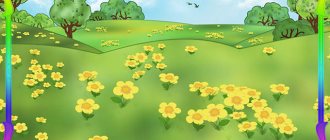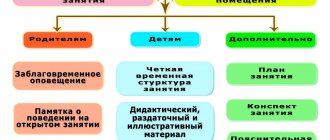Senior group. Senior preschool age. Children 5-6 years old
Summary of an open lesson in the senior group “My native land, which is called Yamal” Program content: To introduce children to the history and traditions of the peoples of the north, to show the peculiarities of culture and life of indigenous peoples, to broaden the horizons of preschoolers. To give an idea of natural resources (oil, gas)
Native land. Develop cognitive interest, speech,...
Summary of an open lesson in mathematics in the senior group “Journey to the Mathematical Kingdom” Summary of an open lesson in mathematics in the senior group “Journey to the Mathematical Kingdom”
I. Program content: Educational tasks: • Practice counting within 10 in forward and reverse order by laying out a number series
(task -1)
• Consolidate knowledge…
MAGAZINE Preschooler.RF
Summary of an open lesson in the senior group according to the Federal State Educational Standard "In search of the seven-flowered flower"Conducted by: Alina Narsovna Kim, teacher at GBOU School No. 2097/8
Goal: formation of elementary mathematical concepts in children of the older group; strengthening the skills of ordinal and quantitative counting (including objects) within the number series of the first ten.
Tasks
Educational
- continue to study with children the properties of the natural series of numbers
- exercise in establishing correspondence between numbers and external properties of objects
- improve the ability to compose a number series and find the place of a number in a series
- strengthen the ability to count within seven using various techniques
- consolidate the ability to analyze objects and isolate the odd one from the presented series according to a characteristic feature
- improve counting skills, the ability to independently compose and solve simple mathematical problems
- consolidate the ability to correctly name ordinal numbers.
Developmental
- develop in didactic games the ability to compare objects, notice minor differences in their characteristics (color, shape, size, quantity)
- develop cognitive processes (speech, attention, logical thinking, imagination, tactile perception)
- develop children's curiosity, mutual assistance, and self-esteem skills
- promote the development of imaginative and logical thinking, the ability to make simple conclusions.
Educational
- develop an interest in mathematics
- develop observation skills when comparing groups of objects
- develop teamwork skills
- cultivate a sense of mutual assistance through cooperation during educational activities, and rejoice in the successes achieved.
Demonstration material: a core and petals of seven colors, a pattern with 5 colors, 3 rows of image sequences, a “wolf, fox and fish” , fly agaric legs with numbers.
Handouts: colored pencils, cards with numbers (for connecting by dots), cards with houses, fly agaric hats with dots.
Structure and course of the lesson:
- organizational stage (3-5 minutes) – motivating start of the lesson;
- main stage (15-19 minutes) – the teacher explains the essence of the exercises that children must cope with, monitors the progress of solving assignments and problems;
- final stage, reflection of activity (3-5 minutes) - the teacher thanks the children for their active participation, conducts with them an analysis and assessment of the results of the work done, reflection of the activity and emotional state.
GCD move
Organizational stage
Educator: Good afternoon, dear children! Today I invite you to go on a journey. And the journey will not be simple, but magical. Far, far away there is a magical country, an extraordinary flower grows there, it can fulfill any wish. What kind of flower do you think this is?
Children: This is Flower of Seven Flowers.
Educator: Correct.
On the top of the flower there are seven magical petals that make dreams come true. Don’t rush to pick them -
There are many roses, daisies, forget-me-nots, poppies, porridges in the world, But there is only one flower in the world - a seven-flowered flower.
Guys, what was the name of the girl who had such a flower?
Children: The girl's name was Zhenya.
Educator: Where did Zhenya get this flower?
Children: The sorceress gave it to her.
Educator: Guys, how many petals does the “Seven-flowered Flower” ?
Children: The seven-flowered flower has seven petals.
Educator: Correct. One day a mischievous wind burst into that country and scattered the petals of a magical flower. The girl Zhenya has only the core left, here it is on the board. Would you like to have such a flower? (Children's answers). Let us then hit the road and collect all the petals of the magic flower. You are ready? (Children's answers) I see that you are ready to travel.
We need to hit the road. Gain intelligence, gain intelligence, find all the petals, so that you can make a wish.
Main stage
Educator: And first we need to arrange the numbers from 1 (one) to 5 (five) in order, starting with the highest flower and ending with the lowest. (Exercise 1 on correlating numbers from 1 to 5 and the length of a flower; the teacher hangs the drawing on the board, the children answer from their seats).
Educator: Well done, children! You completed the task. Oh, look, here is the first petal. What colour is he?
Children: The petal is red. (Ask the child to attach the petal to the middle).
Educator: Guys, let's guess the riddle:
The flower was sleeping and suddenly woke up - He didn’t want to sleep anymore. He moved, perked up, soared up and flew away.
Who are we talking about? (About the butterfly). To test our guess, let's connect the dots in order and see who comes up. (Exercise 2 on connecting “from point to point” under numbers 1-10; the teacher distributes blank cards, children work individually). In front of you is a sheet of paper, and on it there are dots, each corresponding to a number. You need to connect the numbers in order. Who did you get?
Children: Butterfly.
Educator: How many circles are there on the wings of your butterflies?
Children: Six circles.
Educator: Well done! The task has been completed and for this you will be rewarded with a second petal! (Children attach an orange petal to the board)
Educator: How many petals have we already managed to find?
Children: Two petals.
Educator: That's right, how much more do you need to find?
Children: Five petals.
Educator: Let's go on a search further. On the way we came across houses. (Exercise 3 to consolidate ideas about the number series, the ability to name the “neighbors” of a number: the next and previous number; the teacher distributes “houses” , the children fill in the missing numbers). What numbers are hidden here?
Educator: We have filled all the houses and can attach another magic petal to our flower! This time it is yellow.
Educator: (Physical minutes)
The sun hid behind a cloud - But this is only a joke! And we will all have a Sports Minute together:
We'll clap our hands and stomp a little. One - sat down, two - stood up, Three - bent down and took out
The right handle is the shoe, The left handle is the ceiling. And let's sit down one more time! Now let's sit down.
We're a little tired, let's rest for a minute.
Guys, look, while we were playing, the wind brought us another magical petal. What colour is he?
Children: Green petal. (Children attach the petal to the board)
Educator: Guys! A mischievous wind shuffled the cards, and each row got one extra image, let's all find them together? (Exercise 5 – the didactic game “What’s extra?” is designed to explore the processes of figurative and logical thinking; the teacher shows the cards one by one, the children answer from their seats). What's missing in this series? Why? (The teacher takes turns showing the rows to the children; the children must find the extra object and explain why).
Educator: Well done, guys! Hold another petal and attach it, rather, to a magical flower.
Educator: Children, how many petals have we already found?
Children: We found five petals.
Educator: How many more petals do we need to find?
Children: We need to find two more petals.
Educator: And now, together with the wolf and the fox, we will go on a fabulous fishing trip. (Exercise 6 for the formation and development of the ability to independently compose and solve simple mathematical problems; the teacher hangs an application on the board, the children attach fish to it). Look, the wolf caught four fish, and the fox caught one less. How many fish does the fox have? (Three) Place the required number of fish in the fox’s bucket. Which of them caught less and which more? (The wolf caught 1 fish more than the fox) How many fish did the wolf and the fox catch together? (Total 7 fish for two)
Educator: And here is another petal floating to us. What colour is he?
Children: Blue petal.
Educator: Correct, just like the color of the water when a wolf and a fox are fishing. Children, how many petals are we still missing?
Children: We are missing one petal.
Educator: Guys, look, the mischievous wind has scattered fly agaric mushrooms across the clearing: the caps are separate, and the legs are separate. (Exercise 7 “Intricate fly agarics” , children must count the number of dots and find the corresponding “leg” with a number; the teacher gives each child a fly agaric hat, the children independently select the right leg with a number for it). We need to revive the fly agaric, each of you pick up one red cap, count the number of dots on it and select a leg with a number corresponding to the number of dots on the cap of your fly agaric.
Educator: Well done! So we found all the petals. (Children attach the last petal to the board). Now what kind of flower has become but magical?
Children: Beautiful, bright, colorful, multi-colored... (Children's answers)
Educator: Guys, today you told me that you would like to have such a magical flower! Let's try together to remember the magic words to make your wish come true: “Fly, fly, petal through the west to the east, as soon as you touch the ground, in my opinion, you will be led . (Magical music sounds, the teacher at this moment turns over the petals, on the back of which the letters “WELL DONE!” ). Guys, your wish has come true, now each of you has a magical flower “Seven-flowered Flower” , you will be able to make your cherished wishes, which will bring only goodness, joy and happiness to people.
Final stage, reflection of activity
Educator: (Reflection) Children, did you like our trip? (Children's answers) What task was most interesting for you to complete? (Children's answers) What task was the most difficult for you? (Children's answers) How many colorful petals did you and I manage to collect? (Seven) Thank you. You know so much, you were attentive, smart, helped each other, so you coped well with all the tasks that came our way. As a reward for this, I have prepared you a sweet treat and it’s time for us to refresh ourselves after our such a magical journey. I am sure that you will always try as hard as you did today. Well done!
| Next > |
What mathematical knowledge do older preschoolers need?
The program for the senior group of kindergarten provides for a significant expansion and generalization of the most basic mathematical concepts, as well as counting. Children of this age must learn to count to 10 and perceive various objects, not only visually, but also by touch or by sounds.
At the age of 5 years, you can begin to form the concept that any object is divided into several parts of the same or different sizes, and you can compare them. In addition, children are convinced that sets that contain the same number of elements included in it correspond to one natural number (a star has 5 ends, 5 apples, 5 bunnies, etc.).
What is the purpose of classes with preschoolers?
Since the kindergarten has taken over the issue of high-quality preparation of preschoolers for study in the 1st grade, the senior group now takes the same classes as the preparatory group, so that the children have time to develop the necessary skills, perseverance, and the ability to think logically.
The task of the teacher in this case becomes to transfer to children not only the necessary knowledge, but also skills and abilities. This makes it possible to develop curiosity in the child, the ability to work together, independence, and also enriches spiritual and physical culture.
All teachers of preschool institutions must prepare notes for classes in kindergarten. A preschool educational institution that begins to work according to the FOGS system sets the main requirement for training as the presence of various game elements in any of them. Through this form, children acquire the necessary knowledge and skills much better.



